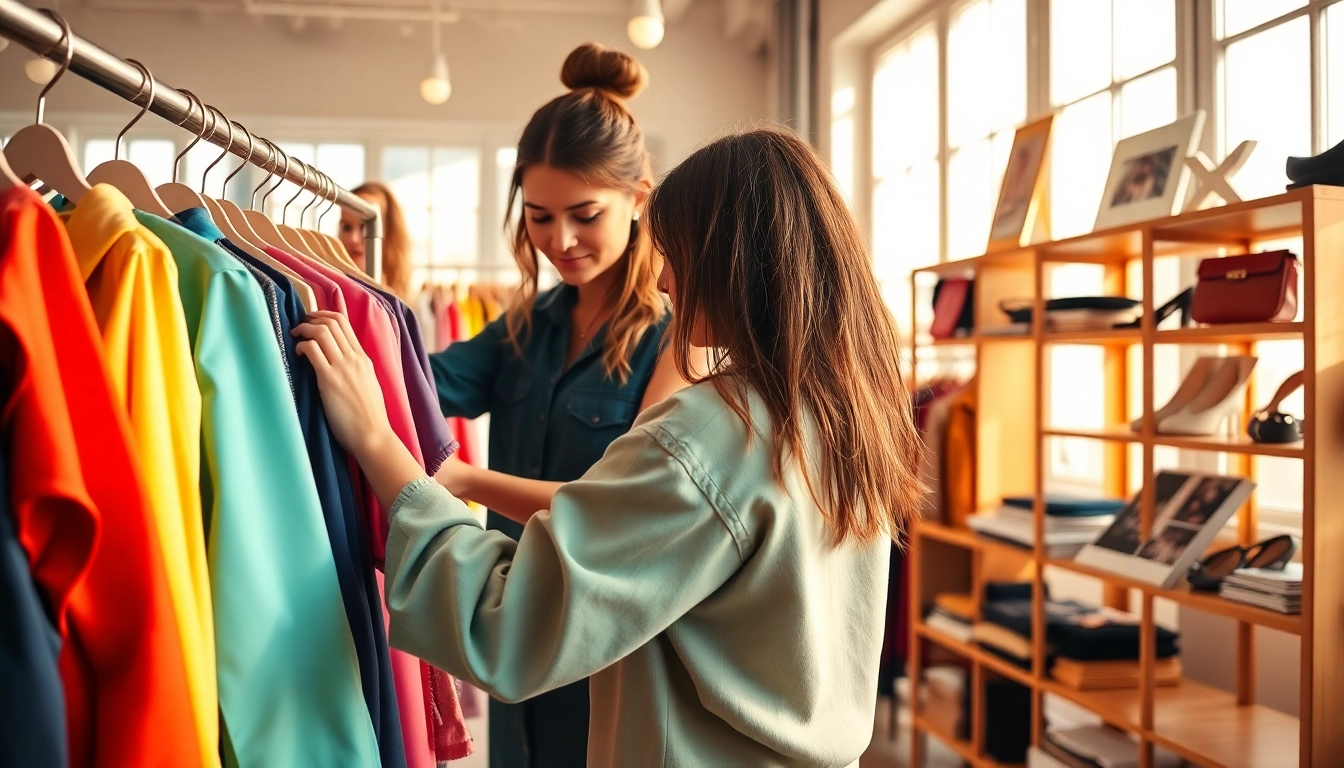Understanding Personal Styling Essentials
What is Personal Styling?
Personal styling encompasses a range of services designed to assist individuals in presenting themselves through fashion in a manner that aligns with their personality, body type, and lifestyle. It involves everything from selecting outfits suited for various occasions to creating entire wardrobes that resonate with one’s personal aesthetic. The primary focus of personal styling is to help individuals showcase their unique selves confidently and stylishly.
At its core, personal styling can help boost self-esteem by ensuring that what a person wears reflects who they are on the inside. By analyzing individual preferences, body shapes, and coloring, personal stylists create tailored recommendations. Today, the rise of technology allows for online services to provide this expertise, meaning that regardless of where you are, you can access advice that empowers your personal fashion choices. This modern approach to personal styling makes it more accessible than ever before.
Benefits of Professional Personal Styling
Choosing to work with a professional personal stylist can yield numerous benefits:
- Time-Saving: Personal stylists streamline the shopping process, saving clients hours of browsing online or sifting through stores for the right pieces.
- Increased Confidence: A well-curated wardrobe that reflects one’s style can bolster self-assurance. People often feel more empowered in their lives when they love their outfits.
- Objective Perspective: Professional stylists bring a fresh eye, helping clients see potential combinations and styles they might overlook.
- Financial Savings: By assisting in creating a well-coordinated wardrobe, personal stylists can help clients avoid impulse buys and ensure they invest in versatile pieces that work together.
- Expertise: Stylists are trained professionals who stay updated on the latest fashion trends, ensuring their clients have access to fashionable advice tailored to their needs.
Types of Personal Styling Services
Personal styling is not one-size-fits-all; it encompasses various services aimed at different needs and preferences:
- Wardrobe Consultations: This service typically involves a complete analysis of a client’s existing wardrobe. The stylist helps identify key pieces to keep, donate, or discard based on the individual’s style goals.
- Outfit Coordination: For special occasions or day-to-day wear, outfit coordination helps create specific looks from existing wardrobe items or newly curated pieces.
- Personal Shopping: Stylists can shop on behalf of their clients or assist them during shopping trips, ensuring they select the right pieces that fit their style and body type.
- Virtual Styling Sessions: With advancements in technology, many stylists now offer online consultations, which can include video chat sessions or detailed online reports and shopping links.
- Capsule Wardrobe Creation: A personalized capsule wardrobe includes a limited number of versatile pieces that can be mixed and matched to create numerous outfits, streamlining daily dressing.
Building a Personal Style Framework
Assessing Your Body Type and Preferences
The first step in personal styling is understanding one’s body type and personal preferences. Virtually all effective stylistic choices should account for the unique shapes, sizes, and proportions of the individual’s body. The primary body types include pear, apple, rectangular, and hourglass. By accurately identifying body type, individuals can choose styles that enhance their best features and provide balance where needed.
Beyond body shapes, preferences in color, patterns, and styles play a crucial role in crafting a personal aesthetic. Reflecting on these aspects is vital in establishing a cohesive personal style framework. Consider keeping a mood board or journal where you can compile inspirational images, fabrics, and styles that inherently attract you.
Creating a Capsule Wardrobe
A capsule wardrobe is a streamlined collection of clothing items designed to maximize outfit combinations while minimizing clutter. It typically consists of timeless pieces that can be interchanged to create diverse looks for various occasions. When curating a capsule wardrobe, consider the following steps:
- Evaluating Your Lifestyle: Identify the demand of your daily activities, whether casual, professional, or formal.
- Selecting a Color Palette: Choose a cohesive color palette that suits your complexion and can be easily mixed and matched.
- Choosing Versatile Pieces: Invest in high-quality staples such as tailored blazers, classic jeans, and neutral shoes that can be paired with multiple outfits.
- Incorporating Trendy Items: Include a few trendy pieces that reflect your personal style, ensuring they can be incorporated into your timeless selections.
A capsule wardrobe is an effective way to reduce decision fatigue while ensuring you always have outfits ready for any situation.
Defining Your Personal Style Aesthetic
Defining a personal style aesthetic involves embracing authenticity and reflecting on what truly resonates with you. Start by exploring fashion inspirations across various sources like social media, fashion magazines, or celebrity styles. Understand which combinations inspire you and look for recurring elements: Are they bold colors? Minimalistic designs? Vintage vibes? Combining these insights provides a clearer vision of your personalized aesthetic.
When nailing down your style, it is essential to tailor it to your personality. A style that resonates will naturally exude confidence and comfort, allowing you to present your authentic self to the world.
Practical Tips for Effective Personal Styling
Curating Your Wardrobe Like a Pro
Successfully curating your wardrobe requires an analytical and creative approach. Begin by decluttering—eliminate items that no longer fit, haven’t been worn in a year, or no longer reflect your personal style. Identify key items that should serve as the foundation of your wardrobe.
Once the decluttering is done, organize your wardrobe in a way that makes sense to you. Some prefer categorizing by clothing type (tops, bottoms, outerwear), while others might opt for color-coordination. This organization leads to greater visibility of available items and encourages mixing and matching.
Accessorizing to Elevate Your Look
The right accessories can elevate any outfit, transforming basic looks into striking ensembles. Accessories include jewelry, scarves, hats, bags, and shoes. Here are some tips for effective accessorizing:
- Balance is Key: For instance, if wearing intricate jewelry, opt for simple clothing to ensure the accessories are the focus.
- Layering: Don’t shy away from layering accessories. Stack bracelets or layer necklaces for a trendy and textured effect.
- Choose Quality Over Quantity: Investing in a few high-quality statement pieces can provide that touch of luxury, whereas fast fashion items may lack the same impact.
Seasonal Styling Trends to Follow
Staying abreast of seasonal trends is vital for refreshing your wardrobe and ensuring styles feel current. Each season typically brings forth new trends that can be incorporated into a personal wardrobe. For instance:
- Spring/Summer: Light fabrics, vibrant colors, and airy silhouettes emerge. Layering becomes flexible with light jackets and cardigans.
- Fall/Winter: This season emphasizes warmth. Fabrics such as knits and heavier materials come into play, and styling often focuses on layers.
However, while trends can be fun, focus on integrating those that resonate with your personal style rather than feeling pressured to conform to every trend.
Personal Styling for Special Occasions
Styling for Weddings and Events
Special occasions such as weddings require thoughtful outfit selection. Begin by assessing the event’s dress code: Is it formal, semi-formal, or casual? Pay attention to the venue and season as well, as these can influence fabric choices and colors. When styling for weddings, some tips include:
- Complimentary Colors: If attending as a guest, avoid wearing white unless specified. Instead, aim for shades that harmonize well with the wedding’s color palette.
- Dressing for Comfort: Comfort is key while remaining stylish. Consider the length of the event and choose footwear and outfits that allow for ease of movement.
Office Attire vs. Casual Wear
Navigating the delicate balance between professional attire and casual wear can be challenging. For professional settings, consider establishing a capsule work wardrobe that involves:
- Tailored Pieces: A well-fitted blazer or dress pants can elevate a professional look.
- Textures and Colors: Incorporating textures or subtle patterns can personalize your workwear without compromising professionalism.
Dressing for Vacations and Getaways
When styling for vacations, versatility is vital. Your outfits should be both stylish and functional. Here are some strategies:
- Mix and Match: Select pieces that can serve multiple roles, such as a shirt that works for both beach outings and casual dinner dates.
- Appropriate Footwear: Ensure you bring comfortable yet stylish footwear for activities ranging from sightseeing to dining experiences.
Tools and Resources for Personal Styling
Best Personal Styling Apps and Platforms
Technology has significantly changed the landscape of personal styling. Numerous apps and platforms offer tailored advice and tools. Some popular features of these platforms might include:
- Personalized Recommendations: Many apps can analyze your wardrobe and suggest outfits based on your style profile.
- Virtual Stylist Services: Some platforms offer virtual consultations that connect users with experienced stylists.
Utilizing Social Media for Style Inspiration
Social media platforms are treasure troves of style inspiration and trends. By exploring the feeds of fashion influencers or style icons, individuals can discover new ideas that reflect their unique aesthetic. Consider creating a style board on platforms like Pinterest to keep track of inspirations and ideas.
Ongoing Education in Personal Styling Trends
Fashion is an ever-evolving field, making it essential to remain updated on trends and styling techniques. Engaging with fashion blogs, podcasts, and online courses can provide continual education in personal styling. Staying informed enhances your ability to make informed purchasing decisions and execute styles that suit your needs.


